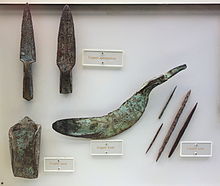Archaic period (North America)
In the classification of the archaeological cultures of North America, the Archaic period or "Meso-Indian period" in North America, starts from about 8000 BC, and it ends at about 1000 BC[source?]. In the sequence of North American pre-Columbian cultural stages, is a period defined by the archaic stage of cultural development. The Archaic stage is characterized by subsistence economies. These economies were supported through the use of nuts, seeds, and shellfish.[1] Because it ended when people started using sedentary farming, this date can be different by a lot across the Americas.

The rest of the Americas also have an Archaic Period.[1]
Classifications
changeThis classification system was first proposed by Gordon Willey and Philip Phillips in the widely accepted 1958 book Method and Theory in American Archaeology.
In the organization of the system, the Archaic period is after the Lithic stage. The Archaic period is before the Formative stage.[2]
- The Lithic stage
- The Archaic stage
- The Formative stage
- The Classic stage
- The Post-Classic stage
References
change- ↑ 1.0 1.1 Willey, Gordon R. (1989). "Gordon Willey". In Glyn Edmund Daniel; Christopher Chippindale (eds.). The Pastmasters: Eleven Modern Pioneers of Archaeology: V. Gordon Childe, Stuart Piggott, Charles Phillips, Christopher Hawkes, Seton Lloyd, Robert J. Braidwood, Gordon R. Willey, C.J. Becker, Sigfried J. De Laet, J. Desmond Clark, D.J. Mulvaney. New York: Thames & Hudson. ISBN 0-500-05051-1. OCLC 19750309.
- ↑ "Method and Theory in American Archaeology". Gordon Willey and Philip Phillips. University of Chicago. 1958. Archived from the original (Digitised online by Questia Media) on 2012-06-28. Retrieved 2009-11-20.
More Reading
change- Claassen, Cheryl (2010). Feasting with Shellfish in the Southern Ohio Valley: Archaic Sacred Sites and Rituals. Knoxville: U of Tennessee P. ISBN 1-5723-3733-8.
- Milanich, Jerald T. (1994). Archaeology of Precolumbian Florida. Gainesville, Florida: The University Press of Florida. ISBN 0-8130-1273-2.